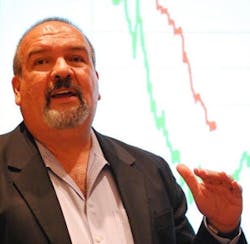Rivero shared his views on the price of oil, how we got here and where we're likely to go next, in his introductory keynote to the oil & gas industry track this week at the Schneider Global Automation Conference in Dallas.
The current 57% percent slump in the price of oil in the 207 days since June 2014 is well in line with the past five "corrections" in the market, according to Rivero. The market essentially recalibrates itself every four to five years, with prices dropping relatively precipitously then slowly recovering. From 2008 to 2009, for example, the price dropped 77% over 169 days then took 472 days to recover half of that value.
"On average, it's 160 days to recover 50% of value," Rivero said. "It's a cyclical business, and this is not our first rodeo."
"Indicators are pointing to further price increases to come." Schneider Electric's Al Rivero is bullish on continued but moderate increases in oil prices over the coming months.
The price of West Texas Intermediate (WTI), an important bellwether for the North America energy market, was $48/bbl on January 22nd, and it's $57/bbl now. "Indicators are pointing to further price increases to come," Rivero said.It's all about the base
More fundamentally, Rivero sees increased production capability from unconventional sources in the U.S. as setting a new global baseline for output that will cycle on and off based on market demand. This base-oil theory should replace past peak-oil models for understanding market dynamics, Rivero said. "Today there is a base level of U.S. production that can come online within months of a sustained price signal of $80/bbl," Rivero explained. "This base production will not disappear at lower prices, but will be put on hold; it will act as a cap, regulating the price."
In the near term, Rivero sees two potential scenarios for the price of oil. In the face of global economic growth (and energy consumption), resilient production will keep volumes growing for the next two years, at which point demand will respond to low prices and the price of WTI will reach $80/bbl in 2017 and $91/bbl in 2020. If, on the other hand, the global economy begins to contract, production volume will continue to grow through 2015, but begin to be throttled back in 2016, with the price of WTI reaching only $65/bbl by 2020.
Rivero also picked some winners that today are benefitting from lower costs of oil as well as natural gas. "If you're in refining, you're in a very good place; crack spreads are very strong," Rivero said. Chemical companies, too, are benefiting from lower energy and feedstock costs. Now's also a good time to pursue optimization projects that drive efficiency and reduce energy consumption, Rivero added. "So when that wave of energy costs comes up, you're more profitable."








